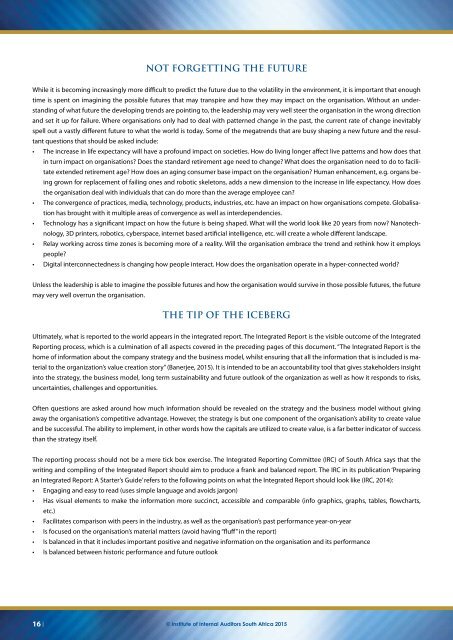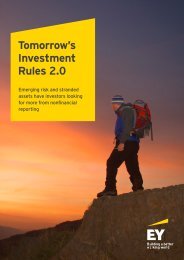INTEGRATED REPORTING TIP OF THE ICEBERG
Integrated_Reporting_Tip_of_the__Iceberg
Integrated_Reporting_Tip_of_the__Iceberg
Create successful ePaper yourself
Turn your PDF publications into a flip-book with our unique Google optimized e-Paper software.
Not forgetting the future<br />
While it is becoming increasingly more difficult to predict the future due to the volatility in the environment, it is important that enough<br />
time is spent on imagining the possible futures that may transpire and how they may impact on the organisation. Without an understanding<br />
of what future the developing trends are pointing to, the leadership may very well steer the organisation in the wrong direction<br />
and set it up for failure. Where organisations only had to deal with patterned change in the past, the current rate of change inevitably<br />
spell out a vastly different future to what the world is today. Some of the megatrends that are busy shaping a new future and the resultant<br />
questions that should be asked include:<br />
• The increase in life expectancy will have a profound impact on societies. How do living longer affect live patterns and how does that<br />
in turn impact on organisations? Does the standard retirement age need to change? What does the organisation need to do to facilitate<br />
extended retirement age? How does an aging consumer base impact on the organisation? Human enhancement, e.g. organs being<br />
grown for replacement of failing ones and robotic skeletons, adds a new dimension to the increase in life expectancy. How does<br />
the organisation deal with individuals that can do more than the average employee can?<br />
• The convergence of practices, media, technology, products, industries, etc. have an impact on how organisations compete. Globalisation<br />
has brought with it multiple areas of convergence as well as interdependencies.<br />
• Technology has a significant impact on how the future is being shaped. What will the world look like 20 years from now? Nanotechnology,<br />
3D printers, robotics, cyberspace, internet based artificial intelligence, etc. will create a whole different landscape.<br />
• Relay working across time zones is becoming more of a reality. Will the organisation embrace the trend and rethink how it employs<br />
people?<br />
• Digital interconnectedness is changing how people interact. How does the organisation operate in a hyper-connected world?<br />
Unless the leadership is able to imagine the possible futures and how the organisation would survive in those possible futures, the future<br />
may very well overrun the organisation.<br />
The tip of the iceberg<br />
Ultimately, what is reported to the world appears in the integrated report. The Integrated Report is the visible outcome of the Integrated<br />
Reporting process, which is a culmination of all aspects covered in the preceding pages of this document. “The Integrated Report is the<br />
home of information about the company strategy and the business model, whilst ensuring that all the information that is included is material<br />
to the organization’s value creation story” (Banerjee, 2015). It is intended to be an accountability tool that gives stakeholders insight<br />
into the strategy, the business model, long term sustainability and future outlook of the organization as well as how it responds to risks,<br />
uncertainties, challenges and opportunities.<br />
Often questions are asked around how much information should be revealed on the strategy and the business model without giving<br />
away the organisation’s competitive advantage. However, the strategy is but one component of the organisation’s ability to create value<br />
and be successful. The ability to implement, in other words how the capitals are utilized to create value, is a far better indicator of success<br />
than the strategy itself.<br />
The reporting process should not be a mere tick box exercise. The Integrated Reporting Committee (IRC) of South Africa says that the<br />
writing and compiling of the Integrated Report should aim to produce a frank and balanced report. The IRC in its publication ‘Preparing<br />
an Integrated Report: A Starter’s Guide’ refers to the following points on what the Integrated Report should look like (IRC, 2014):<br />
• Engaging and easy to read (uses simple language and avoids jargon)<br />
• Has visual elements to make the information more succinct, accessible and comparable (info graphics, graphs, tables, flowcharts,<br />
etc.)<br />
• Facilitates comparison with peers in the industry, as well as the organisation’s past performance year-on-year<br />
• Is focused on the organisation’s material matters (avoid having “fluff” in the report)<br />
• Is balanced in that it includes important positive and negative information on the organisation and its performance<br />
• Is balanced between historic performance and future outlook<br />
16 | © Institute of Internal Auditors South Africa 2015



